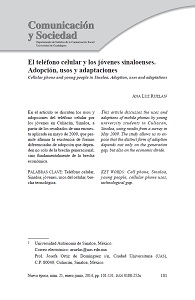El teléfono celular y los jóvenes sinaloenses. Adopción, usos y adaptaciones
DOI:
https://doi.org/10.32870/cys.v0i21.573Palabras clave:
Teléfono celular, Sinaloa, jóvenes, usos del celular, brecha tecnológicaResumen
En el artículo se discuten los usos y adopciones del teléfono celular por los jóvenes en Culiacán, Sinaloa, a partir de los resultados de una encuesta aplicada en mayo de 2009, que permite afirmar la existencia de formas diferenciadas de adopción que dependen no solo de la brecha generacional, sino fundamentalmente de la brecha económica.Descargas
Citas
Chavolla, G. (22 de octubre de 1999). Se duplica demanda de celulares. El Universal. Recuperado el 13 de septiembre de 2013 de http://www.eluniversal.com.mx/finanzas/2447.html
Christensen, T. H. (2009). "Connected presence" in distributed family life. New Media and Society, 11 (3), 433-451.
Clark, L. S. (2009). Digital media and the generation gap. Information, Communication and Society, 12 (3), 388-407.
Comisión Federal de Telecomunicaciones-CFT. (2008). Estadísticas. Recuperado el 21 de noviembre de 2009 dehttp://www.cft.gob.mx/wb/Cofetel_2008/Cofe_densidad_de_telefonia_movil_por_entidadfeder (Este enlace cambió a http://siemt.cft.gob.mx/SIEM/)
Cooper, G. (2002). Mobile society? Technology, distance and presence. En S. Woolgar (Ed.), Virtual society? Technology, cyberbole, reality (pp. 286-301). Oxford: Oxford, Inglaterra: University Press.
Del Villar Alrich, R. (2006). Competencia y equidad en telecomunicaciones. México. Recuperado el 10 de julio de 2006 de http://siteresources.worldbank.org/INTMEXICOINSPANISH/Resources/paper-delvillar.pdf
Estiman en 510 millones de celulares vendidos en 2003. (10 de febrero de 2004). El Universal. México.
Fischer, C. (1992). America calling. A social history of the telephone to 1940. Berkeley, CA, EE.UU.: University of California Press.
Fortunatti, L. (2002). Italy: Stereotypes, true and false. En J. E. Katz & M. Aakhus (Eds.), Perpetual contact: Mobile Communication, private talk, public performance (pp. 42-62). Cambridge, Inglaterra: Cambridge University Press.
Geser, H. (2006). Pre-teen cell phone adoption: Consequences for later patterns of phone usage and involvement. Sociology in Switzerland: Sociology of the mobile phone. Zurich, Suiza. Recuperado el 15 de abril de 2007 de http://socio.ch/mobile/t_geser2.htm.
Goggin, G. (2006). Mobile technology in everyday life. Londres, Inglaterra: Routledge.
Guerrero, G. E. (2009). Las tres guerras. Violencia y narcotráfico en México. Nexos, 32 (381), 33-37.
Haddon, L. (2004). Domestication and mobile telephony. En E. Katz (Ed.), Machines that become us (pp. 43-56). New Brunswick, NJ, EE. UU.: Transaction Publishers.
Humphreys, L. (2005). Social topography in a wireless era: The negotiation of public and private spaces. Journal of Technical Writing and Communication, 25 (4), 367-384.
Instituto Nacional de Estadística, Geografía e Informática-INEGI (2005). II Conteo de Población y Vivienda. Recuperado el 15 de julio de 2008 dehttp://www.inegi.org.mx/est/contenidos/proyectos/ccpv/cpv2005/default.aspx
Instituto Nacional de Estadística, Geografía e Informática-INEGI. (2008). Encuesta Nacional sobre Disponibilidad y Uso de Tecnologías de la Información en los Hogares. Recuperado el 15 de julio de 2008 dehttp://www.inegi.org.mx/prod_serv/contenidos/espanol/bvinegi/productos/encuestas/especiales/endutih/ENDUTIH_2008.pdf
Ito, M. (2005). Mobile phones, Japanese youth, and the re-placemente of social contact. En R. Ling & P. E. Pedersen (Eds.), Mobile communications. Re-negotiation of the social sphere (pp.131-148). Londres, Inglaterra: Springer.
Ito, M. et al. (2008). Living and learning with new media: Summary of findings from the digital youth project.Berkeley, EE.UU.: MacArthur Foundation.
Katz, J. & Sugiyama, S. (2005). Mobile phones as fashion statements: The co-creation of mobile communication's public meaning. En R. Ling & P. E. Pedersen (Eds.), Mobile communications. Re-negotiation of the social sphere (pp.63-81). Londres, Inglaterra: Springer.
Kvasny, L. (2006). Cultural (re)production of digital inequality in a US community technology initiative.Information, Communication and Society, 9 ( 2), 160-181.
Leung, L. & Wei, R. (1998). The gratifications of pager use: Sociability, information-seeking, entertainment, utility, and fashion and status. Telematics and Informatics (15), 253-264.
Lindon, A. (2003). La miseria y la riqueza de la vida cotidiana en la ciudad: el pensamiento de Lefebvre. Revista Litorales, 2, (3). Recuperado el 15 de junio de 2008 de http://litorales.filo.uba.ar/web-litorales4/art-4.htm.http://bit.ly/139hTwu
Ling, R. (2001). The diffusion of the mobile telephony among norwegian teens. A report after the revolution.París, Francia: ICUST. Recuperado el 20 de junio de 2008 dehttp://www.richardling.com/papers/2001_Report_from_after_the_revolution.pdf
Ling, R. (2004). The mobile connection. The cell phone's impact on society. Amsterdan, Holanda: Elsevier/Morgan Kaufmann.
Ling, R. & Haddon, L. (2004). Mobile telephony, mobility, and the coordination of everyday life. En R. Ling (Ed.),The mobile connection. The cell phone's impact on society (pp.245-266). Amsterdan, Holanda: Elsevier/Morgan Kaufmann.
Ling, R. & Yttri, B. (2002). Hypercoordination via mobile phones in norway. Perpetual contact. En K. James & M. Aakhus (Eds.), Mobile communication, private talk, public performance. Cambridge, Inglaterra: Cambridge University Press.
Madell, D. & Muncer, S. (2005). Are internet and mobile phone communication complementary activities amongst young people? A study from a rational actor perspective. Information, Communication, and Society,VIII (1), 64-80.
Mariscal, J. & Bonina, C. M. (2008). Mobile communication in Mexico: Policy and popular dimensions. En J. E. Katz (Ed.), Handbook of mobile communication studies (pp.65-77). Cambridge, MA, EE.UU.: The MIT Press.
Martin, A. (6 de octubre de 2009). Prepaid, but not prepared for Debit Card Fees. The New York Times, p. A1.
Mejía, G. A. (16 de enero de 2006). México, líder en telefonía móvil en América Latina. El Universal. Recuperado el 13 de septiembre de 2013 de http://www.eluniversal.com.mx/finanzas/49444.html
Mejía, G. A. & Jardón, E. (10 de julio de 2006). Sube el gasto familiar en telecomunicaciones. El Universal.Recuperado el 10 de julio de 2006 de http://www.eluniversal.com.mx/finanzas/52970.html.
Okada, T. (2005). Youth culture and the shaping of Japanese mobile media: Personalization and the keitai Internet as multimedia. En M. Ito, D. Okabe & M. Matsuda (Eds.), Personal, portable, pedestrian. Mobile phones in Japanese life (pp.41-60). Cambridge, MA, EE.UU.: The MIT Press.
Putnam, R. (2000). Bowling alone. The collapse and revival of American community. Nueva York, EE.UU.: Simon y Schuster.
Rheingold, H. (2002). Smart MOBS. The next social revolution. Cambridge, Inglaterra: Basic Books.
Rice, R. & Haythornthwaite, C. (2006). Perspectives on Internet use: Access, involvement, and interaction. En L. Lievrouw & S. Livingstone (Eds.), Handbook of new media: Social shaping and consecuences of ICTs (pp.92-113). Londres, Inglaterra: Sage.
Rogers, E. M. (1986). Communication technology. Nueva York, EE.UU.: Free Press.
Rogers, E. M. (1995). Diffusion of innovations. Nueva York, EE.UU.: Free Press.
Ruelas, A. L. (2010, julio/diciembre). El teléfono celular y las aproximaciones para su estudio. Comunicación y Sociedad, 14, 143-168.
Santamaría Gómez, A. (11 de octubre de 2009). Defensor del lector. Noroeste. Recuperado el 14 de abril de 2010 de http://www.noroeste.com.mx/publicaciones.php?id=519549
Stewart, J. (2005). Context perspectives for scenarios and research development in mobile systems. En L. Hamill & A. Lasen (Eds.), Mobile world. Past, present and future (pp. 161-194). Londres, Inglaterra: Springer.
Telecomunicaciones, nadie las detiene. (27 de noviembre de 2007). CNN Expansión. Recuperado el 27 de noviembre de 2007 de http://www.cnnexpansion.com/economia/2007/11/27/telecomunicaciones-nadie-las-detiene
Thulin, E. & Vilhelmson, B. (2007). Mobiles everywhere: Youth, the mobile phone, and changes in everyday practice. Nordic Journal of Youth Research, 5 (3), 235-253.
Wei, R. & Lo, V. H. (2006). Staying connected while on the move: Cell phone use and social connectedness. New Media and Society, 18 (1), 53-72.
Wellman, B. & Haythornwaite, C. (1999). The Network Community. An Introduction. En B. Wellman & C. Haythornwaite (Eds.), Networks in the global village (pp. 3-41). Boulder, CO, EE.UU.: Westview Press.
Williams, R. & Edge, D. (1996). The social shaping of technology. Research Policy, 25, 865-899.
Woolgar, S. (1991). Configuring the user. En J. Law (Ed.), The sociology of monsters: Essays on power, technology and domination (pp.57-93). Londres, Inglaterra: Routledge.

Descargas
Publicado
Cómo citar
Número
Sección
Licencia
Los autores/as que publiquen en esta revista aceptan las siguientes condiciones:
De acuerdo con la legislación de derechos de autor, los autores conservan los derechos de autoría y otorgan a Comunicación y Sociedad el derecho de primera comunicación pública de la obra. Comunicación y Sociedad no realiza cargos a los autores por enviar y procesar artículos para su publicación.
Los autores/as pueden realizar otros acuerdos contractuales independientes y adicionales para la distribución no exclusiva de la versión del artículo publicado en Comunicación y Sociedad (por ejemplo incluirlo en un repositorio institucional o publicarlo en un libro) siempre que indiquen claramente que el trabajo se publicó por primera vez en Comunicación y Sociedad.

























